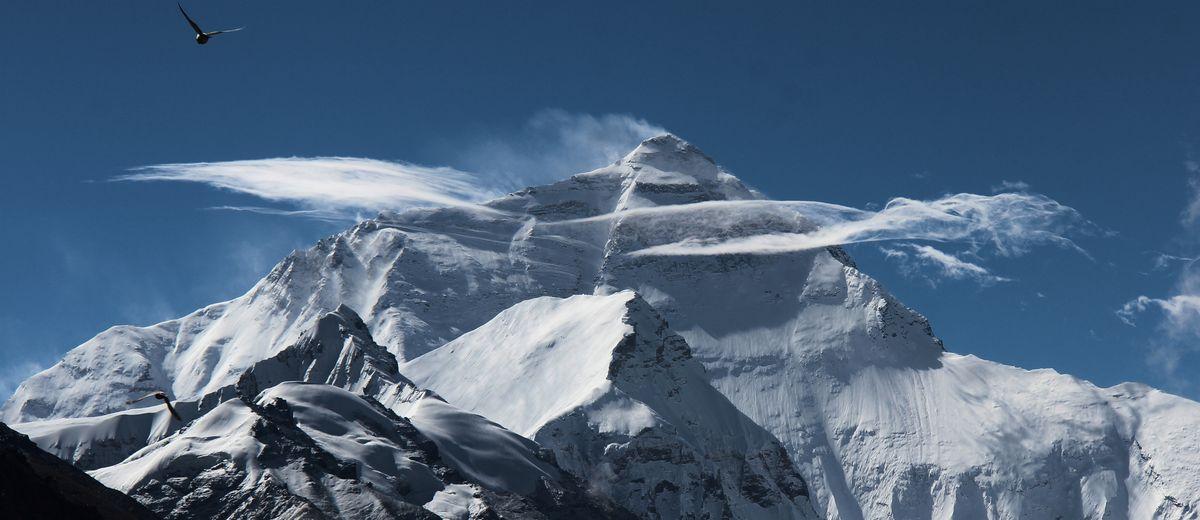1. A Human Traffic Jam
Despite Everest costing thousands of dollars to climb, more people than ever are trying to summit it. In 2012, German mountaineer Ralf Dujmovits captured a shocking image showing hundreds of climbers lining up to reach the summit. Ralf had made the decision to turn back at the South Col of the mountain due to poor weather conditions when he spotted the painfully long queue.
On May 19, 2012, climbers crowding one landmark near the summit faced atwo-hour wait. In the course of just half a day, 234 people managed to reach the peak—but four people died, raising major concerns over the climbing process. Nepal specialists that year added a new fixed rope to ease congestion, and there have even been talks of installing permanent ladders.
2. It’s Growing
Both Chinese and Nepalese ideas of the mountain’s height may be wrong, according to more recent measurements.A research team discovered in 1994 that Everest continues to grow approximately 4 millimeters (0.16 in) every year. The Indian subcontinent was originally an independent landmass that collided with Asia, forming the Himalayas, and the continental plates are still moving, pushing the mountains ever higher.Researchers from the American Millennium Expedition in 1999 placed a global positioning satellite device below the summit to measure growth. Their more accurate findings from the modern technology led to the official height of Everest being changed to 8,850 meters (29,035 ft). Meanwhile, other tectonic activity actually costs the mountain height, but the overall movement seems to be upward.
3. Two Men Climbed It 21 Times
Two Sherpas, Apa Sherpa and Phurba Tashi, hold the joint record for most Everest ascents. The pair have each managed to reach the summit an impressive 21 times. Phurba reached the top of the world three times in 2007 alone, and Apa has successfully summited the mountain almost every year between 1990 and 2011. Apa says that he has seen clear changes on Everest caused by global warming over the years. He has spoken of his concerns over melting snow and glaciers, which expose the rock and make it increasingly tough to climb. He also worries for the well-being of Sherpas, after losing his own home in a flood caused by the melted glaciers. Apa has dedicated several Everest ascents to raising awareness of climate change.
4. Mountain Spiders
Even high in the sky, with barely enough air to breathe, we still can’t hide from spiders. Euophrys omnisuperstes (“standing above everything”), better known as Himalayan jumping spiders, hide in nooks and crevices on the slopes of Everest, making them one of the Earth’s highest permanent residents. Climbers have spotted them as high as 6,700 meters (22,000 ft). The tiny spiders manage to feed on whatever stray insects the severe winds blow up the mountain. They’re virtually the only animals permanently based at such a high altitude, aside from a few species of bird. In addition, several previously unnamed grasshopper species were collected during the famously ill-fated 1924 British Everest expedition and are now on display in the British Natural History Museum.
5. Multiple Names
Although we know the mountain as “Everest,” Tibetan natives have called the mountain by the ancient name “Chomolungma” (also spelled “Qomolangma”) for centuries. The Tibetan name means “Goddess Mother of Mountains.” But that isn’t the only other name it goes by. The Nepalese people know it as “Sagarmatha,” meaning “Forehead in the Sky,” so the mountain is now a part of the Nepalese “Sagarmatha National Park.”The mountain was only named “Everest” when British surveyor Andrew Waugh failed to find a commonly used local name. After studying maps of the surrounding areas and still being unable to make a decision, he named the mountain after Indian Surveyor General George Everest, head of the British team that first surveyed the Himalayas. Colonel Everest objected to the honor, but the British officially changed their name for the mountain from “Peak XV” to “Mount Everest” in 1865.


